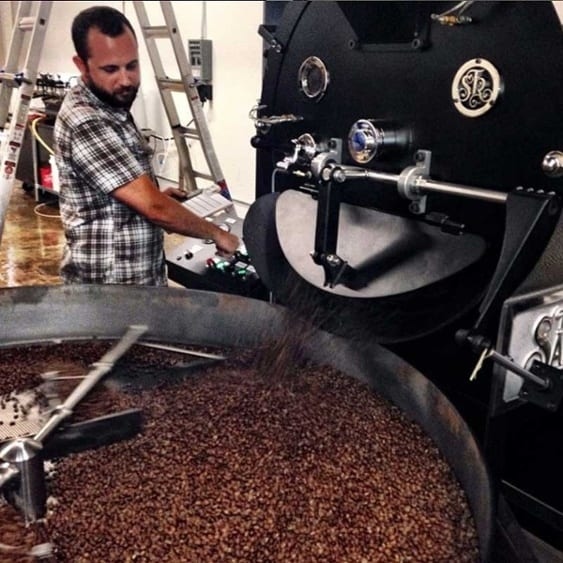Coffee Roasting Guide: What Is Airflow & How Can You Control It?
FEBRUARY 28, 2019 Written by Angie Molina

https://www.perfectdailygrind.com/2019/02/coffee-roasting-guide-what-is-airflow-how-can-you-control-it/?fbclid=IwAR0b8g24Qfe7_VNhqjcZtpm1r2hUWcqNG49bqat4iPvIRrckNOwOrbO14rw
Coffee roasting: it all comes down to heat. But did you know that the majority of the heat transferred during roasting is due to airflow? That’s according to Don Cox of Bald Guy Brew and The Coffee Roasting Institute.
I reached out to several roasting professionals, including Bill Kennedy, Founder of coffee roaster manufacturer The San Franciscan Roaster Co., to ask: What is airflow? How does airflow affect coffee roasting? And how can coffee roasters manipulate this tricky variable for better roasts?
Read on to discover their answers.
What Is Airflow?
“Airflow is pretty simple,” Bill tells me. “It really is what it sounds like. It really has to do with the movement of the system and how that air impacts what is going on within the system.”
It may be simple, but it opens up a world of opportunity. A roasting machine will always have some degree of airflow, especially because heat causes air movement. However, you can also change the airflow during the roast.
“We can manipulate the temperature of the air, the velocity of the air, the pressure of the air…” Bill says.
So, why would you want to vary airflow? Because airflow is a key component in the roasting process.
The Relationship Between Airflow & Heat
Let’s quickly revisit middle school science: energy in the form of heat can be transferred by conduction, convection, and radiation.
In roasting, conduction is what happens when the coffee beans are being heated directly by the metal of the drum. Heat passes from one solid to another. Convection, on the other hand, is the heat transfer caused by airflow.
Don tells me, “Airflow is one of the key mechanisms by which taste, aroma, and color are developed by air through the roast… Air is critical for heat transfer, for the combustion of gas, and it is critical for the development of the coffee.”
That being said, airflow isn’t just about heat: Bill reminds me that airflow also removes chaff and small particles from the beans during roasting.
However, playing with airflow is a key part of controlling a roast. “Changing those ratios between conductive and convective [heat transfer], that is where the craft roaster changes the outcome,” Bill says.
“And because coffee is such a complex and organic product, you can roast coffee a million different ways and have a million different excellent outcomes in your cup of coffee. And that is one of the exciting things about coffee.”
What Is The Impact of Airflow on Flavor?
Roasting needs both conductive and convective heat transfer. They complement each other – especially when it comes to flavor.
“In the most general sense,” Bill says, “conductive heat transfer is where you are going to lock in flavors and sweetness… I won’t say that they are mutually exclusive, but where conductive heat transfer will lock in flavors and sweetness, convective heat transfer will help to find and give you greater clarity with those flavors.”
Diagnosing Airflow Problems
There is no singular “right way” for anything in coffee roasting: not for charge temperature, not for roast time, and certainly not for airflow. Everything varies depending on the beans, the machine, and the roaster’s vision for this coffee.
In other words, we can’t say “you should always have an airflow between X and Y”. However, there are certain guides that can help roasters work out when the airflow was too low or too high for this particular coffee in this particular machine with this particular roast goal.
When there’s not enough airflow…
Dave Farfara of Shenandoah Joe in Charlottesville, USA, tells me that when the airflow is too low, there isn’t enough convection-based energy transfer. Roasters may see this in the form of low temperatures. And the result of this temperatures is baked coffee – beans with a dough-like profile where they spent too long slowly cooking in the roaster.
Don agrees, advising, “Too little airflow – which could be the result of poor maintenance or a fan that is underpowered to produce the necessary cubic feet per minute (CFM), a measurement of the velocity at which air flows into or out of a space – can result in a ‘muted’ acidity… an acidity with no character or that’s flat.”
But it’s not just about the coffee’s development. Bill says, “If you don’t have good airflow… you are not removing the impurities that you don’t want… These impurities can potentially burn and become ash on a microscopic level inside the drum, which will eventually give a kind of ashy flavor to your beans, even if they have a beautiful looking roasted appearance.”
Michael McIntyre of Catalyst Coffee Consulting agrees with him. “Not enough air movement and the batch will not have good cup clarity. In that case, the coffee will likely have a carbon quality from not effectively removing the exhaust.”
When there’s too much airflow…
On the other hand, if airflow is too high, the beans tend to heat too quickly. Michael warns that this can lead to tipping, where the edges of the beans become scorched. Due to the intense heat, the outside of the bean burns before the inside has an opportunity to develop.
Even if the roaster avoids tipping, the impact can still be tasted in the cup. Don says, “Generally speaking, an excessive amount of airflow will cause sourness due to the shortened roast.”
Airflow Temperature, Velocity, & Pressure: What’s The Difference?
So far, we’ve been talking about airflow as if it were one simple thing. Unfortunately, it’s not that easy. The heat transfer during roasting is affected by the temperature, velocity, and pressure of the air.
Bill says, “The temperature of the air is important but the velocity of the air going by is also important, and the greatest risk…”
In other words, oversimplify airflow at your peril.
Yet while airflow velocity is important, you might find yourself relying on pressure measurements instead. “Testing airflow velocity is difficult because, whether there is an airflow meter or something like that, smoke and oils can obstruct those devices,” Bill explains. “Pressure and velocity have a direct correlation to each other, so the best next thing is to use the pressure gauge, like a Magnehelic.”
What does pressure have to do with velocity? “Actually, velocity and pressure are very closely related because we are not really manipulating the pressure as much as we are manipulating the velocity and the temperature of the air,” Bill tells me.
In other words, you control the velocity but do this based on the pressure readings. “The more of the negative pressure you experience… means higher velocity,” Bill explains.
While this might seem complicated at first, it will get easier with time. “Your mind will start making associations between the dial setting on the Magnehelic, which you will notice in your software, and ultimately your time and temperature benchmarks, with your nodes of your pressures settings,” Bill reassures me.
How to Control Airflow
It’s one thing to understand what airflow velocity is and the impact of it. But how do you control it? Michael recommends adjusting the dampener or variable fan at critical points in the roast.
He adds that some roasters prefer to use the full airflow and adjust other variables, such as the gas pressure or flame application.
As an additional tip, he recommends keeping the batch size at 50–60% of the drum capacity “if you find that your roaster does not promote good air movement.”
But remember, you don’t want the same amount of airflow at all stages of the roast.
Varying Airflow Throughout The Roast
Let’s look at the roast process step-by-step:
Bill says, “If you have too much convective heat [airflow] at the beginning of the roast, you are removing moisture too quickly, in my opinion. We want the drying to happen [but] we don’t want the beans to become so dry that we lose flavor notes.”
Don agrees. “In the beginning of the roast, you want to have less air so you can let the heat into the bean for an endothermic reaction (the energy being absorbed in the form of heat), because we need the Maillard reaction to happen, we need the Strecker to develop, we need pyrolysis to occur.”
When yellowing begins, it’s time to adjust the airflow. “We need to help the bean out,” Don says, “because, at this point, we know that dehydration is occurring. So, we open the air so that it helps to strip the free water molecules off of [the coffee].”
And Michael reminds me of the importance of airflow on the end temperature. “A machine that has more airflow control can reach a desired mass loss at a lower end temp than one lacking that control/efficiency.”
One Example of How You Might Vary Airflow
But controlling airflow isn’t just about following a set pattern. As Michael says, “Just as you would adjust the flame, and even the drum speed, for different coffees such as Pacamara, Maragogype, peaberries, naturals and lower-density coffees, it is equally important to observe airflow.”
So, how would he adjust the airflow for these? He takes the example of natural processed coffees. “I tend to prefer less airflow through the drying phase on naturals, gradually increasing airflow going into the post-first-crack phase.”
We’ve already discussed how conductive heat can enhance sweetness and convective heat, or airflow, clarity. And natural coffees are known for their sweetness and fruitiness, while washed coffees are better known for their cleanness.
“I think the fruit and sugars in naturals are enhanced by promoting better conductive heat,” Michael continues. “However, you also have to be a bit more aggressive with airflow through the later portions of the roast, because naturals can become easily muddled through poor exhausting.”
Even here, though, there is room for experimentation. “It is also not a one-size-fits-all rule,” Michael stresses. “Coffee always surprises us.”
Airflow: it’s key to roasting. And while it might seem simple – more airflow means more convection heat and better clarity – mastering this is as challenging as every other element of coffee roasting. How much airflow should you use for that high-altitude natural coffee with great sweetness? How quickly should you increase airflow during drying for that washed Colombian?
But the more we experiment with coffee roasting, the more we discover. And that is one of the most exciting things about this craft.
So, play with airflow. Try different profiles with the same coffee and the same profile with different coffees. Take notes, evaluate and, most of all, have fun.
咖啡烘焙指南:什麼是“氣流(風流)”?如何控制“氣流(風流)”?
部份重點摘要…
*熱源和咖啡烘焙有直接關係,而氣流和熱源之間的相互作用也息息相關...
*氣流是烘焙過程中關鍵的要素...
*我們可以控制烘焙爐內空氣的溫度,速度,壓力...
*熱源的傳遞可以透過傳導,對流,輻射...
*氣流在烘焙過程中不僅關係著熱源,也可以幫助我們排除銀皮或加熱過程中產生的灰燼...
*由於咖啡是一種複雜且有機的物質,你可以用許多不同的手法烘焙,使其產生許多不同的風味,這也是咖啡讓人著迷的地方...
*氣流的控制,在咖啡烘焙過程扮演著至關重要的角色...
*"傳導熱"較能鎖住咖啡的甜味,"對流熱"較能呈現咖啡的明亮度...
*無論是烘焙溫度,時間,或是氣流,都不可能是主導咖啡烘焙的唯一途徑;和豆子本身,烘焙機的類型,烘焙者的想法等等也都息息相關...
*氣流太小,熱源傳遞慢,使得咖啡烘焙時間過長,造成" baked coffee"...
*氣流太小,空氣流動不足,廢氣和灰燼無法順利排出,可能會使你的咖啡產生焦炭味...
*氣流過大,會使得升溫太快,造成豆子內外受熱不均,並容易產生不好的酸味...
*在烘焙過程中,"熱"的傳遞受到氣流的溫度,氣流的速度,氣流的壓力影響,而其中溫度是重要的,但氣流速度也很重要,風險也更大,..
*The San Franciscan Roaster Co.的創始人Bill Kennedy說,在烘焙開始時,如果你使用了過大的氣流,雖然可以達到脫水的目的,但我們不希望在這階段讓你的豆子過度乾燥,而失去該有的風味...
*Bald Guy Brew and The Coffee Roasting Institute的Don Cox 說:咖啡烘焙一開始,不適合過多的氣流,因為你需要"熱"進入你的豆子,進行吸熱反應,進行熱解作用.當豆子"轉黃點"時,就是該調整氣流的時候了,因為這時候我們需要多一點的氣流協助你的豆子排除多餘的游離水分子...
*Catalyst Coffee Consulting的Michael說:烘焙不同的咖啡,你可以調整火源大小,調整滾筒轉速,一樣的,在烘焙不同的咖啡時,氣流的調整也不是一成不變的,他以日曬豆為例,他傾向在乾燥(脫水)階段以較少的氣流,之後再逐漸增加氣流進入一爆階段...
*
*
*
咖啡舖子 Ryan Chien 2019/03/03



 留言列表
留言列表


